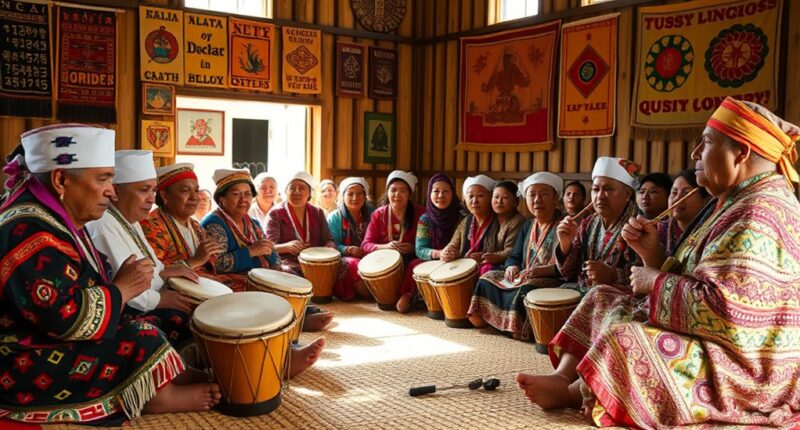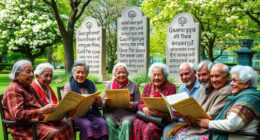Music and song play a crucial role in revitalizing endangered languages by creating emotional bonds and strengthening cultural identity. They engage communities actively, passing traditions across generations through storytelling, dance, and shared singing. By integrating traditional melodies and new compositions, you can make language learning more meaningful and immersive. Using technology further supports these efforts, inspiring future generations to keep the language alive. Discover how music can transform your approach to language preservation.
Key Takeaways
- Music and song foster cultural connections, transmitting language, history, and identity across generations.
- Singing creates emotional bonds, motivating communities to preserve and actively engage with their native language.
- Traditional and new songs serve as tools for community transmission and collective cultural pride.
- Integrating music into education makes language learning immersive, relevant, and culturally expressive.
- Technology enhances access and engagement with traditional music, supporting sustainable language revitalization efforts.

Language revitalization often finds a powerful ally in music and song, as these art forms can evoke deep cultural connections and inspire communities to reclaim their linguistic heritage. When you integrate music education into language revival efforts, you’re tapping into a universal medium that resonates across generations. Music isn’t just entertainment; it’s a vessel for transmitting cultural knowledge and reinforcing identity. Through songs, you can teach vocabulary, grammar, and pronunciation in engaging ways, making learning both memorable and meaningful. When community members participate in singing traditional songs or composing new ones in their native language, they strengthen their cultural identity and foster a sense of pride. This active participation helps keep the language alive, especially among younger generations who might otherwise lose touch with their roots.
Involving music and song in language revitalization also creates an emotional bond that static lessons rarely achieve. When you sing in your ancestral tongue, you connect to ancestors and shared history, creating a sense of continuity and belonging. This emotional connection motivates people to preserve and pass on their language. Music education becomes a fundamental part of this process, as it offers a dynamic environment where language isn’t just learned but experienced. Schools and community programs that incorporate traditional music or develop new compositions in indigenous languages provide learners with a sense of ownership and relevance. These programs often incorporate storytelling, dance, and cultural practices, making language learning immersive and culturally rich.
Furthermore, music can serve as a bridge between generations, transmitting linguistic and cultural knowledge that might otherwise fade. When you participate in singing traditional songs, you’re actively engaging with your community’s history and values. This shared activity fosters unity and encourages collective effort toward language preservation. It also provides a platform for cultural expression, where individuals can explore their identity through lyrical storytelling, melodies, and rhythmic patterns rooted in their heritage. As you become more involved, you realize that music isn’t just an art form; it’s a essential tool for sustaining language and culture.
In addition, high-quality audio and visual equipment can enhance the learning experience by making traditional songs more accessible and engaging, thereby supporting revitalization efforts. In essence, by embracing music education and integrating song into language revitalization, you help create a living, breathing cultural identity. You empower communities to take ownership of their linguistic heritage while forging emotional bonds that inspire ongoing efforts. Music becomes a symbol of resilience, a means to celebrate history, and a catalyst for future generations to keep their language vibrant and relevant.
Frequently Asked Questions
How Do Indigenous Communities Fund Music-Based Language Revitalization Projects?
You can fund your language revitalization projects through cultural funding from government grants or arts organizations, which support indigenous initiatives. Additionally, seek community sponsorship by partnering with local businesses, nonprofits, or cultural groups willing to invest in preserving your language through music. Crowdfunding platforms also work well, engaging supporters who want to see your community’s language thrive. Combining these sources guarantees sustainable funding for your music-based language efforts.
What Are Some Successful International Examples of Music-Driven Language Preservation?
Think of music as a bridge connecting generations and cultures. International examples like New Zealand’s Māori waiata revitalization and Australia’s Aboriginal song projects showcase how music-driven efforts strengthen cultural identity and foster musical innovation. These initiatives engage communities, preserve languages, and inspire pride. Your participation in similar projects can spark global recognition, proving that melodies are powerful tools for safeguarding endangered languages and celebrating diverse cultural heritage worldwide.
How Can Non-Native Speakers Effectively Participate in These Musical Initiatives?
You can effectively participate in musical initiatives by engaging in cultural exchange and language immersion experiences. Join workshops or collaborative projects that involve native speakers, and practice singing or performing songs in the target language. Active listening and singing help reinforce pronunciation and vocabulary. By immersing yourself in the music and culture, you not only learn language nuances but also show respect and support for preservation efforts.
What Role Do Technology and Digital Platforms Play in Modern Language Revitalization?
Have you ever wondered how technology can save dying languages? Digital platforms and virtual workshops play a vital role by creating digital archives and online communities, making language learning accessible worldwide. They enable learners to connect, practice, and share resources anytime, anywhere. These tools foster engagement, preserve linguistic heritage, and inspire new speakers—so why not leverage technology to keep your language alive and thriving in the digital age?
How Is the Impact of Music-Based Efforts Measured in Language Preservation?
You measure the impact of music-based efforts by tracking engagement levels, such as participation in performances, workshops, and digital sharing. You also assess cultural impact through community feedback, how well the language is retained, and whether songs are incorporated into daily life. These indicators help you understand if your initiatives are effectively revitalizing the language, fostering pride, and strengthening cultural identity through musical expressions.
Conclusion
By engaging with music and song, you play a crucial role in preserving and revitalizing endangered languages. Imagine this: studies show that children learning through song are 60% more likely to remember vocabulary. Your participation helps keep these languages alive, ensuring future generations can connect with their cultural heritage. So, keep singing, keep sharing—your voice can make a powerful difference in safeguarding linguistic diversity for years to come.
Mary is a passionate writer who brings creativity and a fresh perspective to our team. Her words have the power to captivate and inspire, making her an essential contributor to our content. Mary’s commitment to storytelling and dedication to promoting Indigenous culture ensures that her work touches the hearts of our readers. We’re fortunate to have her as part of our team.









